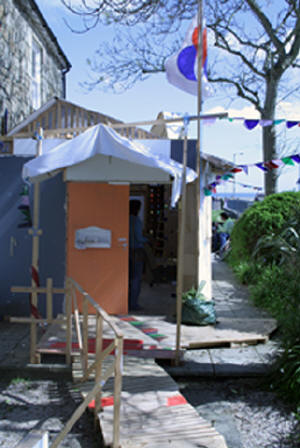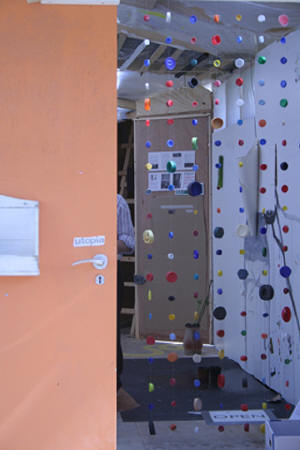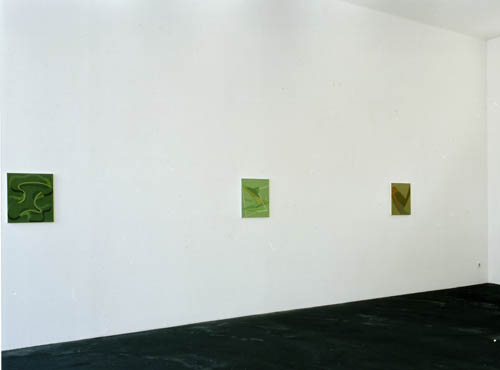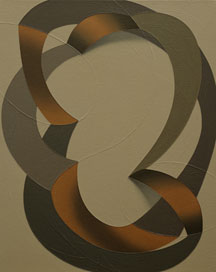| art-cornwall | |||
| home | features | exhibitions | profiles | gazetteer | links | archive | |||
|
features Reflections on Provisional Newlyn The original
Newlyn Gallery, home of the Newlyn Society of Artists, was opened in 1895. It
was commissioned by Passmore Edwards, who was responsible for the building of
the Whitechapel Picture Gallery. Its current period of renovation and partial
relocation meant that the gallery would have closed altogether had Dominic
Thomas not been asked to establish an alternative presence in the interim, a
place which would serve both as an information centre and be an artwork in its
own right.
The shed is a fitting location for a transitional art. It has connotations of retreat, of workshop for the mundane or spectacular, of makeshift den to house the imagination. It is democratic architecture in the sense that anyone with a modicum of DIY sense can build one. The haphazard construction that is Provisional Newlyn, complete with tower, veranda and insignias, declares its eccentricity and shows that you don’t have to stick to the rules on the IKEA flatpack box. Dominic Thomas and his assistant Jonty Lees see the building process itself as part of the project, and recall the construction with schoolboy enthusiasm. It is less self-conscious and certainly less rigidly organised than The Other Flower Show at the V&A, (2004) where a group of well-known artists were each asked to transform a garden shed. Provisional Newlyn owes more visually to the gaffer-taped cardboard constructions of Thomas Hirshhorn, and like his work, it sacrifices craftsmanship and quality in the interests of harnessing energy. Dominic Thomas’s work has moved into process-based areas where the location of the actual artwork is not easy to define. Like his mobile project Mundusloci, where he and his family took a VW van around Europe, Provisional Newlyn has been diarised with photos and film. Three leaflets have been produced over the course of the month in an attempt to crystallise conceptually and philosophically some of the themes that have arisen from the project. In PN # two Martin Wooster states “A community gives us the potential to both affirm our legitimate differences from each other and to explore all our diverse dimensions, but this is only possible if something of this constituted space in part remains indeterminate, escapes all calculation.” Does the equivocal nature of Provisional Newlyn allow for such explorations? Certainly in the organic way a programme of events developed, not only through the response of invited artists, but also, refreshingly, by people requesting a slot after visiting or hearing about the project. Indeed the atmosphere and function of the shed has been transformed according to the style in which it has been temporarily inhabited by different personalities over the month. Alexis Stevens
and Charles Napier used the opportunity for an experiment in collaborative
three-dimensional “drawing” employing found materials in a game of visual
consequences. Lilly Keal and William Ainley from Bristol responded to the garden
shed connotations and transformed the space with theatrical flair in a
fantastical recreation of an actual location. There was a visit from
Lucy Willow
and Marion Taylor in their ‘In-Transit’ mobile art van, and talks on the
philosophy behind recycled bikes by a local blacksmith, Dave Tigwell. Other pieces relied heavily on interaction with visitors. Mary Fletcher drew portraits as the sitters described an event they had just missed and Jane Bailey used the space as “an incubator to hothouse ideas” for a session of Latin Plant Verse. Oliver Sutherland created an imaginary tube station by painting the yellow line of a platform edge across the floor and playing sounds recorded on London Underground - the audience becoming willing participants in this illusion, Coinciding with the Easter holiday pilgrimage to the Cornish coast, there was a steady stream of visitors and their children. It appeared that some would rather gnaw off their leg than engage with an art event. Looking scared at the obvious absence of Newlyn School painters, they were cordially dispatched to nearby Penlee House where the actual collection is housed. Others were fascinated or simply took advantage of the distraction offered by the informal kids workshops that developed daily. The democratic nature of the project and the lack of a clear agenda on the part of the “facilitators” meant all interested parties had to receive an equal welcome and introduction to whatever was going on. Because the project had no specific boundaries, the nature of the audience was also unspecific - nothing could be assumed about them and this could not be controlled. Kids from the local park infiltrated the space and had drawings of their own dens displayed on the walls, and the last time I visited a man wheeling a dog around in a wooden trolley was asking when his digital prints would be exhibited. The transience of the environment encouraged a rapid, open-ended evolution of ideas to develop and interestingly, this use of the space as a site for experimentation ties in with Thomas’s preoccupation with the themes of chance and failure. By creating something without preconceived ideas about outcome, in a space that is neither private studio nor public gallery, how do you define your activity, let alone measure the success or failure of your endeavour? For all those who took part there was the challenge of working in a public place, sometimes having to provide a commentary for an indefinite process. Alexis Stevens said she felt like a piece of art herself but enjoyed the opportunity to take risks in public without the pressure of an agreed brief or even guidelines. Amanda Lorens revelled in the performative opportunity offered by the space and physically adapted it to suit her needs. She shut her audience out and made voyeurs of the spectators, letting them spy on her and her partner as they danced a forty-five minute tango. This unfolded metaphors around the shed as a sanctuary at the bottom of the garden – a site for seedy intimacies or obsessive tendencies had been re-imagined as a private world where the everyday becomes fabulous. There is something quite humbling about the whole venture in the sense that artists were laying bare the process that is an essential part of their practice in an atmosphere that was without hierarchy or pretension. It provided an uncensored forum for dialogue. Makeshift and awkward, far from perfect, Provisional Newlyn was a very human endeavour. Provisional Newlyn ran from 8th April to 6th May 2006 Megan Wakefield July 2006
How helpful is Art School in London to a Cornish artist? Many believe that throughout the 90s London was the epicentre of the international art-world. Students from abroad seemed to queue up to be accepted onto the degree and post-graduate degree courses at the 4 (or 5) most influential colleges there. It was viewed my many of them, as it was by home-grown talent, as an invaluable stage in their careers. In fact I know of several artists living in Cornwall, who attended these same art schools and others like them, but who struggle to make much of an impact on the art scene in Cornwall. And in many ways I count myself among their number. There are a number of explanations for this phenomenon. Perhaps attending art school in London is a handicap; at least for an artist who lives down here. Perhaps these artists are over-qualified. Perhaps through their training they have lost touch with the "less-developed' sensibilities of the average man on the street. Perhaps they are speaking a different language: an empty, meaningless language that is quickly recognised and understood in elitist art circles, but not elsewhere. But what can and should be done? Should artists fitting this description just pack up their bags and move out? Should they abandon their practice and adopt something more accessible? Should they forget about reaching a Cornish audience and just focus on exhibiting elsewhere? I don’t have the answers but these are some of my reflections on the issue. Firstly good art transcends boundaries of taste and sensibility. What ever you think about the Saatchi collection, one thing you can say is that it is able to delight and/or shock aficionados and lay-people alike. Damien Hirst’s pickled shark and Richard Wilsons oil installation, for example, can elicit a response in anyone who isn’t dead from the neck up. I see this, ultimately, as a good thing. Secondly artists that I know in London struggle with the same problem of remaining accessible to their audience. This is not a problem unique to Cornwall. Communicating effectively is part of the skill and challenge of being an artist. Some artists accept that, ultimately, they will only ever have a small audience for their work because it may be too risqué or too intellectual for the average lay-person. Thirdly there aren’t that many artists in London, particularly if they are making installation or process based art, who make much of a living doing so - even if pretty successful. They all have to supplement their income by teaching or having second careers or a spouse that supports them financially (now that must be nice!), so imagining things might be different in Cornwall is fanciful. Lastly (and this is a more controversial point) Cornwall does have certain things going for it. In particular its tradition of landscape-inspired abstract art still seems to find favour in local commercial galleries in a way that it would not in any other provincial region. I see this as an opportunity to view positively and to take advantage of. So going to art school in London isn’t all bad. The journey may be longer and the challenges greater for a Cornish artist, but I’d like to think, the experience makes the artist wiser and more insightful in the end. And certainly the work is likely to be better for it. Nb I wrote this article about London because I lived there for many years and know the galleries and art-schools there fairly well: but the issues apply to any artist with a post-graduate degree, particularly if they attended art-school in the 90s when the YBAs and conceptual art were reigning supreme and hardly anyone was painting RW july 2006
Why being an abstract painter makes sense in the context of the Cornish Art Scene
I don’t know if its living in Cornwall that’s done it, but since returning here from London I’ve been happy making abstract art. The thing that’s difficult about making abstract art of whatever kind is that as the artist you can’t put much of yourself in the work, except in a very tangential and elusive way. What I mean by this is you cant put much humour in, or deep psychological or political content. (The exception is when you come to title the work: Howard Hodgkin once called one of his paintings ‘Small but my own’, which I think is hilarious). It’s taken me a while to restrain myself like this, and let me tell you it’s been hard, but I’ve finally achieved it, and I’m glad about that. In fact I’m proud to announce: as an artist I have ‘nothing’ to say. The reality is that abstract art is about ‘nothing’ and how nothing relates to being. This kind of thinking is mystical and Heidiggerian in a good way, and I find it endlessly nourishing. A stone ‘is’. It has being, but not much else, and that is what is miraculous about it. Buddhists talk of the state of ‘no-mind’. My understanding of this is that it is a state we enter into as humans when we are no longer striving, when we are calm and our minds are resting and empty. The self dissolves away, and we are left with our sense of being in the universe, an object or being amongst others. No different to blades of grass or rocks on the shoreline. It might sound sentimental, but actually it’s the thing people in Cornwall value about living here. We have more opportunity to reach a psychological state of tranquility. Imagine you’re walking alone on an empty beach. It’s not sunny or raining: just a non-descript grey day. The sea washes in, in relentless waves, and your mind, hypnotised by the sound, becomes calm, and empties. At those times we glimpse what ‘being’ is. It is those times that we value most, and it why so many of us would never swap the bars and boutiques of the metropolis for our simpler, humbler lives down here. Zen Buddhism was a big influence on West Coast minimalist artists like Agnes Martin, where being is glimpsed in the form of stillness and subtle cosmic vibrations. But there are also some great Cornish abstract artists like Feiler, Frost and Blow who tap the same rich vein albeit in a lighter and more funky way. And it makes sense to make this kind of work down here. People talk about the quality of light. Too obvious. They talk about the visual impact of the landscape. Too superficial. Actually I think Cornwall exerts a special effect on the psyche. Surrounded by the sea on all sides (nearly) we have a constant reminder of the sublime and of how small human beings are in the grand cosmic order. It is this psychological fact that makes for inspiring abstract art. Abstract art provides a way of contemplating and approaching the cosmos, and provides a bridge to being itself. It’s therefore no accident that the Cornish art scene was at its peak in the 50s. It was then that abstract art as a world art movement was at its strongest. Inevitably Cornwall became less influential when Pop Art came along. Suddenly metropolitan artists could, once again, make art about the city around them and about the welter of advertising codes and sexualised imagery that goes with them. Fantastic. (The corollary of this is that it doesn’t make much sense being a figurative artist down here, and in my view the Cornish figurative artist runs the risk of being a bit middle of the road, for some of the reasons I have outlined). But obviously that is just an opinion, and I know of some notable exceptions. Also you may question the value of aspiring to a state of calm and ‘no-mind’. In fact you might just want to use art to party with. Well that’s OK, but other art-forms fulfill that function for me. Talking of which have you heard Roy Ayres?……. RW May 2006
Tomma Abts, the Turner Prize and Cornish painting
Tomma Abts is a highly regarded painter who this year was nominated for the Turner Prize following impressive shows at Greengrassi, London and Kunsthalle Basel, Switzerland. Her paintings are small by contemporary standards. They are abstract, carefully constructed and have an understated, muted palette. In fact in virtually every respect they look like modernist paintings of the early St Ives School. Some could have been painted by Noam Gabo, Peter Lanyon or John Wells. How is it possible that, in 2006, such apparently derivative ‘retro’ work can be considered for a prize as prestigious as the Turner Prize, and what are the lessons for contemporary abstract artists working in Cornwall? Firstly serious abstract paintings don’t have to be big. Size is best judged in relation to the body: a painting is either larger than a person, about the same size, or smaller. Like animals, or other people, the scale of a painting dictates ones emotional feelings towards it. The larger a painting is, the more likely it will have a imposing, visceral impact. In contrast, smaller paintings lend themselves to being contemplated intellectually because they don’t invade our body space in the same way. Thus scale imparts certain overlooked but important aesthetic qualities to a painting. Secondly its OK to revive apparently dead forms and styles, especially if there are ways of breathing life back into them. Abts does this, I think, by introducing playful Vasarely-like Op Art effects into the compositions, e.g. by painting in shadows to create an ambiguous 3D space. Even if she wasn't giving them this added value, more than 50 years on, her work is different from the modernists because the context in which she is working has changed immeasurably. Whereas e.g. the contructivists and Mondrian were hugely idealistic, contemporary artists tend not to be. But when one of them tries to hark back to another era in their work, that act in itself is a strong statement about their views of the present. Thirdly, constructivist/geometric abstract art is not going away. For the last 100 years it has kept returning and reinventing itself. There is something irreducible and intransigent about it. If only more Cornish artists would recognise this fact and incorporate more of the strong geometric forms typical of mid-century Cornish abstraction into their work….
RW June 2006
|
|||



